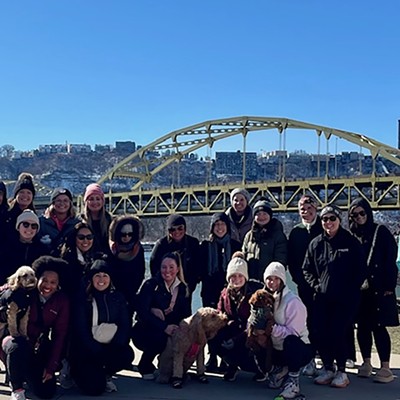Geneva Jackson wants the city to know that her neighborhood is not a dump -- even if it's often used as one.
Leading the way from her home on Lombard Street, the 65-year-old Hill District resident passes three "No Dumping" signs as she descends a flight of city steps to Diaz Way. "Take a look at this," says Jackson, gesturing toward the hillside below the street. "People use this like a landfill."
Indeed, hundreds of tires lie scattered down the slope. A little further up the road sits a knee-high pile of rubbish, roughly 10 feet across. Inside it are large garbage bags, scrap wood and a broken fan.
"This is sinful!" Jackson shouts, lifting a plastic bucket as she sifts through the mess.
Illegal dumps are a danger and an eyesore. Often they're created by contractors or haulers trying to avoid disposal fees; other times they're the result of residents who don't care, or don't know, how to dispose of items the city won't pick up at the curb.
It's no secret that illegal dumping is a problem: A study released last July by PA CleanWays, a statewide advocacy group that targets dumping and littering, reported 279 illegal dump sites inside Pittsburgh. Combined, the sites held 676 tons of trash, the report estimated.
But identifying the problem is just the first step -- solving it is much harder.
Eight months after the study was published, neighborhoods from Greenfield to Garfield, Brookline to Carrick still suffer from trash-covered hillsides.
Take Diaz Way. Last spring, CleanWays hauled away the trash strewn about the hillside. By fall, though, the area was once again littered with nearly 200 tires.
Some community activists want to use surveillance cameras to catch dumpers in the act. As it stands now, says Public Works Director Rob Kaczorowski, "It's difficult to catch dumpers. It's almost a game of cat-and-mouse: Catch me if you can."
"It's very easy to dump here," says Bob McKinley, executive director of Allegheny CleanWays, the local chapter of PA CleanWays. "Because of [the city's] steep hills and dead-end streets, we are a geographical paradise for dumpers."
Not surprisingly, neighborhoods with the steepest hillsides have the worst problems with illegal dumping. At the time of the PA CleanWays study, Carrick had 19 illegal dump sites, totaling more than 111 tons of garbage. Greenfield, meanwhile, had more than 40 tons of trash at 20 different sites.
Often, McKinley says, contractors or individuals don't want to pay to get rid of trash the city's Public Works department won't collect during the weekly curbside pick-up -- stuff like tires, concrete and shingles. "So they say, 'Where is the nearest vacant lot or hillside?'" says McKinley. "That's what we're constantly dealing with."
On average, McKinley says Allegheny CleanWays cleans 10 to 20 dumps sites each year. With the help of volunteers and city crews, the group has cleaned 11 of the city's 279 dump sites since the study's release last summer. But, he says, "Dumping is still occurring on a regular basis."
"It's a huge problem," says Derek Green, president of local cleanup group Stash the Trash. In the past three months, his organization has cleaned seven illegal dump sites in the city, and it hopes to clean at least 30 more this year.
But such efforts often provide only momentary relief. "If you clean [a dump site] tomorrow, they might be back the next day," says Kaczorowski.
Contractors and individuals often dump illegally, he explains, rather than spending the time and money for proper disposal.
Residents too are part of the problem. City dwellers can dispose of two bulk items -- like sofas, toilets or large televisions -- at the curb each week. Beyond two items, Kaczorowski says, residents must call the city's Bureau of Environmental Services to schedule a special curbside pick-up. However, that costs $100 for each half-hour it takes to finish the job.
As for household recyclables (like glass and newspaper), those not picked up at curbside can be taken to various centers, like the one near Construction Junction, in Point Breeze. Tires and yard debris, however, must be taken to Public Works drop-off centers -- in the East End, West End or Hazelwood. (There is no charge for drop-offs of up to two tires, without rims.)
Kaczorowski says his crews are well aware of the city's illegal dumping sites. Since the CleanWays study was released in July, he says, Public Works has cleaned up many of the problem spots. "Once we're made aware of dump sites," he says, "we try to get rid of them as soon as possible."
But, he says, dumpers will continue doing it "until they get caught."
The state's Department of Environmental Protection (DEP) shares authority with the state police and other agencies. Both the Allegheny County Health Department and the city police can issue dumping citations: Fines can reach $10,000.
But few citations are being written. According to Pittsburgh Police statistics, just 27 citations were issued in 2009. That's up from zero in 2007 and 20 in 2008. Similarly, Guillermo Cole, spokesperson for the county's Health Department, says that the number of citations written by health officials is also low. The County Health Department, meanwhile, has issued just 12 citations for illegal dumping in the last three years. It issued five each in 2007 and 2008 and just two last year.
The law is hard to enforce "because people must be caught in the act of committing the crime," writes police spokesperson Diane Richard in an e-mail. "Typically, when people illegally dump, they will do it under the cover of night ... in an area that is remote, isolated or abandoned."
The dump site near Kim Petho's Hazelwood house fits the description. The 44-year-old's home sits a stone's throw from multiple mounds of wood and concrete that rest at the shoulder of Harlem Street, just shy of a steep hillside.
"Sometimes there is tons of stuff," says Petho, adding that she regularly sees tires and shingles among the trash. And even when she spots dumpers in the act, it's tough to read dumpers' license plates: "They usually do it at night."
Clearly, "No Dumping" signs and barricades aren't enough. Sometimes, Kaczorowski says, signs can advertise a site to dumpers. And barriers rarely stop them.
Some are calling for a more aggressive tactic: installing surveillance cameras at active dumping sites. The cameras could pick out license-plate numbers and other identifying information.
"We need eyes that never close," says City Councilor Doug Shields, whose district includes Greenfield and Hazelwood, two neighborhoods with the highest tonnage of illegal dump waste.
Last spring, CleanWays applied for a $23,000 grant from the DEP to help fund clean-up efforts and pay for eight surveillance cameras. The grant was approved, says McKinley -- but without $4,000 earmarked for cameras.
DEP spokesperson Katy Gresh says the state currently uses nine cameras at some of the most problematic dump sites statewide -- though none of them are located in Pittsburgh or Allegheny County. The cameras "are pretty effective," she says, noting that in a four-year period they have positively identified roughly a dozen illegal dumpers.
Asked if the number of cameras would increase, however, she said, "Our budget has been stretched pretty thin. I'm not sure that's a viable option in the immediate future."
McKinley plans to start fundraising efforts for cameras this year, hoping that their implementation "will help change the attitudes of some of the dumpers." Cameras can cost from $350 to $6,000 each.
Joanna Doven, Mayor Luke Ravenstahl's spokesperson, did not respond to an e-mail asking whether the mayor would consider installing cameras at illegal dump sites. But Kaczorowski agrees cameras "would definitely be a detriment to dumping."
"The placement of cameras ... would be a helpful deterrent," echoes police spokesperson Richard. But until that happens, she adds, the police have to rely on tips from residents.
"Unfortunately, the police cannot be in all places at all times," Richard writes. "If members of the community can help, ... those committing the crime can be charged."
But Geneva Jackson says she can't patrol the Hill District on her own.
"Cameras would deter this," says Jackson, as she begins trudging up the stairs back to Lombard Street. "Big Brother's got to be watching these people."














